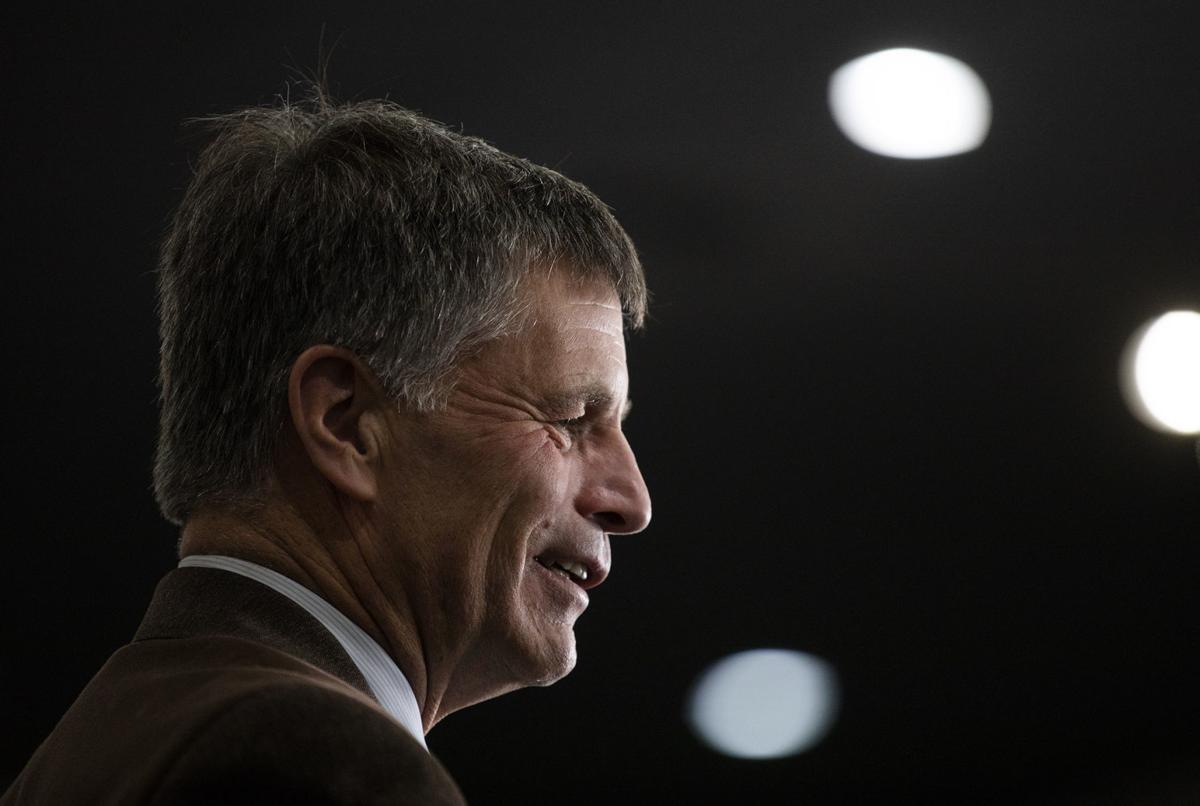Wyoming Governor Mark Gordon's Administration Takes a Magnifying Glass to Wyoming's Tax Structure

By Nick Reynolds
June 25, 2019 - In a press conference earlier this year, Wyoming Governor Mark Gordon told reporters he wanted to take a “realistic look” at the state’s energy dependent tax system and better understand the implications of the Wyoming’s seemingly endless cycles of boom and bust.

Governor Mark Gordon talks with attendees during at Industrial Hemp Summit in April in downtown Casper.
Photo by Josh Galemore, Star-Tribune
On Friday, the leaders of Wyoming’s economic development group, Endow, got an early glimpse at how Gordon plans to accomplish that review.
Led by University of Wyoming’s Steve Farkas – the assistant dean for its business school’s MBA program – the Energy Futures Modeling Group will spend the next several months developing an understanding of the state’s energy-dominated revenue streams. The group’s work will include simulating future prospects for the state’s primary revenue sources and modeling the impacts of ebbs and flows in prices on different areas of the state.
The study – which is focused primarily on the state’s energy-dominated tax structure – is meant to serve as a foundation to future talks about the state’s tax structure, and what opportunities or risks any changes would create.
“These are very early discussions,” Farkas said in his presentation to the Endow Council. “Fundamentally, we’ve created a framework for these discussions to move forward. But it’s very important for this group to have input from you all, and would like to solicit that input as we think about innovative ways to position the state’s key energy assets in a way to generate new sources of revenue.”
To start, the group will focus solely on coal revenues, but that analysis could be extended to oil and gas later.
Plugging information from the state’s coal industry into the model, the group will be able to produce revenue projections based on the state’s existing tax structure as well as structures used in similar states – like South Dakota – to help determine how different aspects of each model affect revenues. For instance, the model could be used to compare how the state’s revenues would be impacted under different tax structures if coal were to decline 6 percent, versus a 20 percent decline.
Those modeling scenarios will be presented to the Legislature’s Joint Revenue Committee for approval next month.
With more data, the administration hopes to build a base understanding of the state’s economy that Gordon’s office and the Legislature needs to make informed decisions about how the state earns its money.
“We’re not changing the revenue model or even offering recommendations at this point,” said Renny Mackay, a policy advisor for Gordon. “We’re just looking at the different scenarios for energy, specifically coal.”
Building a knowledge base of the state’s declining coal industry has become a crucial building block to Gordon’s economic strategy. In prepared remarks, Gordon told members of the Endow Council he was “concerned” with the sustainability of Wyoming’s mineral revenues as a pillar of the state’s economy – a familiar refrain given the volatility of commodities like oil and coal.
As climate change continues to put increasing pressure on the market, understanding the state’s energy-reliant revenue streams will become more important for state lawmakers in the future, with the governor’s modeling group looking to evaluate the impacts other shifts in the market could have.
“We’re starting by looking at coal, but realistically this is about fossil fuels in general, and I think we’ll be looking at oil and natural gas in the future as well,” said Buck McVeigh, Gordon’s economic policy advisor. “I think eventually, we’ll be shifting our focus over to natural gas, because as we heard in the meeting, natural gas is another carbon emitter, so it’s very likely natural gas will be where coal was 25 to 30 years ago. We’ll be taking a look at all reductions in fossil fuels.”
Ultimately, any policy recommendations or changes will be driven by the Legislature. Some in the state – like the libertarian Wyoming Liberty Group – have shown significant reservations toward taking the scalpel to the state’s tax structure, speculating that any changes could lead to tax hikes in the future – a familiar bogeyman among the state’s most strident anti-tax conservatives.
However, Gordon’s office maintains that these discussions are very preliminary, and are less about guiding changes to the state’s tax structure than they are about understanding it as it currently is.
“There is such an opportunity for more information to be out there for all people in Wyoming to consider,” Mackay said. “That’s going to inform future decisions. If there are future cuts, the decisions we make will have to be collaborative.”

